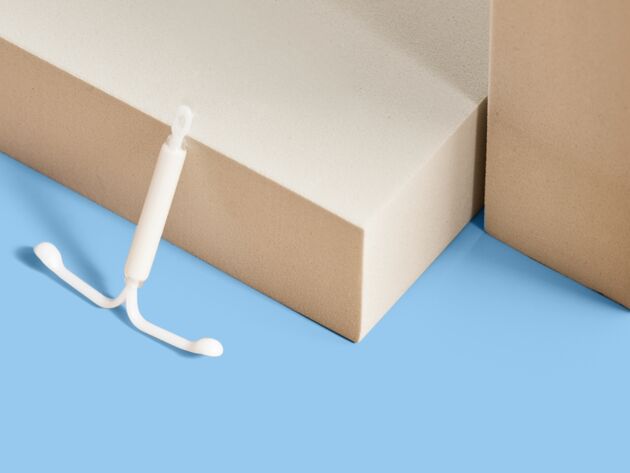Can You Get Mirena Again if It Expelled

Written by Michelle No
The number of women and people who menstruate who use an IUD (or gyre) has increased dramatically in the concluding decade. And it's no surprise — IUDs are incredibly effective at preventing pregnancy and require little maintenance.
Read on for our guide to getting an IUD and what to exercise if yours falls out (too known equally "expulsion"). Remember: Your health care professional is the best offset point of contact for all things contraception, so book an appointment as a starting point.
Take a quiz
Discover out what you tin can do with our Health Assistant
What is an IUD?
Let'due south get-go with the nuts: An intrauterine device (IUD) or curl is a small-scale, T-shaped device that is placed inside the uterus to forbid unplanned pregnancy. There are two dissimilar types to choose from: a non-hormonal IUD that's covered in copper and a hormonal IUD that releases progestin (a synthetic form of the hormone progesterone).
IUDs accept become hugely popular for people who employ contraception, in office because they're hassle-free, long-lasting, and 99 pct effective at preventing pregnancies when professionally inserted. It'due south a win-win-win situation.
How does an IUD work?
The two types of IUDs may expect similar, but they really work in pretty unlike means.
A non-hormonal copper IUD works by releasing copper ions, which repel sperm and keep them from reaching an egg.
On the other hand, a hormonal IUD prevents pregnancy in several ways. It thins the lining of your uterus, which makes information technology harder for a fertilized egg to attach, and it thickens the mucus effectually your cervix (the lower end of the uterus), making it harder for sperm to get through. On top of all that, the progestin released past the IUD also stops ovulation, meaning your ovaries won't release an egg that could potentially exist fertilized. The hormonal IUD is as well approved by the Food and Drug Administration (FDA) for treatment of heavy menstrual bleeding. Pretty cool.
Why practise IUDs accept strings?
If you've ever seen an IUD, you lot've probably noticed the two pocket-sized pieces of string dangling from the bottom. Those strings are really an essential part of the IUD'south design. They help you check that your IUD is in place and help the doctor remove information technology when the fourth dimension comes. Think of them like the strings on a tampon.
What's IUD insertion like?
IUD insertion starts off similar many trips to the gynecologist. To begin, a nurse or doctor will ask y'all most your medical and sexual history. They might also perform a pelvic examination, which might include using a swab to collect a sample of cervical cells. If this is the case, your medico should explain the examination beforehand so you understand what it entails and can fully consent.
And then, they'll utilize a speculum to gently open up the walls of your vagina and a tool called a tenaculum to stabilize the cervix. Before they can insert the IUD, they'll need to measure your uterus and so that they can insert the IUD correctly. So they'll use some other tool to guide the IUD into the uterus. When the IUD reaches the correct depth (indicated past uterine sound), the IUD is pushed out of its tube and immune to open into the "T" shape yous're familiar with. Stabilizing the neck, measuring the uterus, and inserting the IUD tin can all crusade cramping. For some people, it's a walk in the park, but for others, it can hurt quite a lot (simply only very briefly!). Some doctors recommend taking a hurting reliever before your engagement, just in case.
How can I expect to experience after an IUD insertion?
Your body is unique, so how you feel subsequently an IUD insertion might vary a lot from how someone else feels. You lot might not feel whatsoever side effects at all, or you might experience cramps or backaches. Spotting is too a common side result. All of these sensations are completely normal.
Boosted side effects depend on what kind of IUD you had inserted. If yous had a copper IUD inserted, then your menstruation might get heavier and your cramps more than intense. Alternatively, if you opted for a hormonal IUD, you might have lighter periods or find your period stops birthday. Again, this is normal.
What if I tin feel my IUD strings coming out (or can't experience them at all)?
Now, IUDs are pretty reliable — that'southward why and then many people opt for them. But hey, things happen, and your IUD could autumn out. If your IUD'south strings feel longer or shorter than usual, or you tin't feel the strings at all, information technology's possible that your IUD has moved or fallen out. Just don't freak out: It's likewise possible that the strings have folded on themselves and but aren't within reach or that the IUD has moved a piffling higher.
The only mode to exist sure is to make an appointment to get information technology checked out. Just remember that, more often than not speaking, if your IUD has moved or been expelled, and so it won't prevent pregnancy. If it'southward shifted to a lower function of your uterus, so it may all the same be effective. However, if yous suspect it's moved, information technology's a skillful idea to consult your medico. Until your date, you should employ a fill-in class of birth command (such as condoms) while you expect for your doctor to give yous the all-articulate.
These are some signs your IUD has moved or been expelled:
- Discomfort during sex
- A modify in menstrual bleeding
- Increased cramping

Why has my IUD moved or been expelled?
While virtually IUDs never move, IUD expulsions (when IUDs fall out) do occur in two–x percent of patients. And it'southward quite easy to run into why they happen when you consider that the uterus is a muscle that contracts.
Dr. Barbara Levy, Clinical Professor of Obstetrics and Gynecology at the George Washington Academy School of Medicine and Health Sciences (and Flo Medical Board member), explains that "for some, this muscle contracts very, very firmly." That's often when expulsions happen because the uterus contracts around the IUD and pushes it toward the neck.
As logic follows, people with heavy bleeding or heavy cramping or people who might have an uneven uterine surface might be more likely to expel their IUD. In these cases, the muscles are either contracting harder than usual or aren't able to concord the IUD in place, she says.
According to Dr. Levy, some other cistron that can determine whether yous might be more likely to expel your IUD is if your torso has a greater production of prostaglandin, which is the chemical that causes the uterus to contract.
That said, people who are most likely to have their IUDs autumn out are patients aged 14–19 years.
Can an IUD fall out without you knowing?
It's rare, says Dr. Levy, but it's possible to pass your IUD through a blood jell — without even realizing information technology — if y'all're someone who has a very heavy flow. The primal discussion hither is "rare."
Mostly, if your IUD falls out, you'll experience the plastic or the strings of the IUD or feel some cramping. "It's more probable that you'll experience some symptoms associated with the expulsion," says Dr. Levy.
How tin can I check if my IUD is still in identify?
To check that your IUD hasn't prematurely left your uterus or moved, you should effort to regularly check your IUDs strings in the first few months afterward it'south been inserted. Just remember not to pull on the strings, or y'all could accidentally remove information technology yourself!
To bank check if your IUD is withal in place, wash your easily, squat or sit downward, then slowly insert a finger into your vagina. You might non feel the strings right away, in which example, you lot might want to reach a trivial college. If you notwithstanding don't feel the strings, so schedule an appointment with your health care professional to make sure everything is in the right place. And again: Just be sure to use another method of contraception (such as condoms) until you get the all-clear.
What happens if my IUD isn't in my uterus?
If yous've checked for strings and gone to a medico for an ultrasound, and you and your doctor still can't locate your IUD, and so the side by side step might be to practise an X-ray. Perforation of the uterus with an IUD is extremely rare, only it does happen. Given merely how rare it is, though, Dr. Levy recommends not worrying too much about the possibility.

Source: https://flo.health/menstrual-cycle/sex/birth-control/iud-expulsion
0 Response to "Can You Get Mirena Again if It Expelled"
Post a Comment